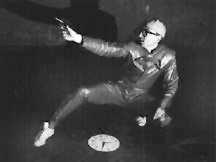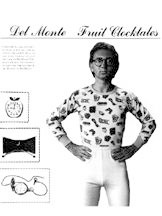- MAIN INDEX | ARTIST INDEX
| February 17 - March 7, 1981 David Buchan
| |
 David Buchan, "Modern Fashions", 1980. Photo David Buchan. 18K |  David Buchan, "Del Monte Fruit Cocktales", 1980. Photo David Buchan. 18K |
| Buchan sells revolution in the best satirical style John Bentley Mays
"Tell them who you are. When you've got something to say, don't just say it - wear it!" David Buchan, whose 1979 work Modern Fashions is now on view at Mercer Union (29 Mercer St.), decided to become an artist five years ago. And what did he choose as the stuff of his art? Paint, that old favorite? Metal - welded, cast, or banged together? Or one of the more up-tempo, fast-lane media such as video? Answer: none of the above. "I got to thinking about what I enjoyed most," Buchan recalls. "It was getting dressed up. " From that day until this, David Buchan has been getting dressed up in various items from his huge collection of uniforms, get-ups, outfits, and assorted duds - then parading these clothes through a series of marvelous performance works based on pop-culture formats (fashion show, TV variety hour, etc.) in Toronto and across Canada. And getting dressed up also is the subject of Buchan's current show of large photodocumentary work at Mercer Union. First shown in the winter of 1980 at Calgary's Glenbow Museum - whose assistant art curator, Peter White, organized it - it's a remarkable installation that proves there's much more to David Buchan than a closet full of clothes. The basic format Buchan exploited for this series of large blow-ups was the Esquire mens-wear ad, circa 1960. In these handsome, satirical sendups of that famous ad style, Buchan himself appropriates the roles of model (he plays most of the parts, though real-life models Michael Lacroix and Anya Varda make guest appearances) and rag-trader (the clothes are all his own). He also does everything an ad agency would do - from writing the copy to directing the shoot. (George Whiteside and General Idea's Jorge Zontal, however, did the actual photographs which are terrific. All of it comes together in one central intention to focus attention on what he calls the "language of partial seduction" which is advertising. The word partial in the show's sub-title points to the "casualness involved into the selling process" - the teasing, off-handedly charming, not-quite-serious syntax sixties-style advertising which Buchan has understood so exactly and whose ironies he has captured so well. Whether pushing pyjamas ("you can unravel the knitted sleeve of care in the fabulous fabrics of the Lamonte del Monte Nite-wear Collection") or Cam-o-flage Brand Underwear (''blending into one's surroundings and chameleon-like behavior are prerequesites for living in the modern world"), Buchan manages to sustain the tension between the absurdity and seriousness, and between the surface and "subliminal meanings of the ad - his copy glitters with wickedly funny double entendres, many drawn from the universal homosexual argot known as "the queen's English." But these works are more than cultural investigations into language, fashion, and clothes merchansing - although they are wonderful examples of that. As Buchan himself suggests, they are intended to comment on the more high-toned arena of selling called the art world. Like Spadina Avenue (Toronto's garment district), Queen Street and Yorkville (the city's gallery neighborhoods) are periodically hit with tides of this or that fashion, from colorfield painting to new image painting, from abstract weldings to photo-narrative. Criticism invaluably responds with some new, sexy language to describe the new art- a kind of parallel to changing fads in ad-copy. Potential unwary buyers are treated to exactly the same come-on and temptation Buchan beautifully satirizes in his ads for gold lame cowboy boots and neo-fascist fashion accessories (worn by advocates of the "'No Panty Line' party line"). But what about the ultimate worth of Buchan's strongly critical art? Isn't it just about as trendy as any of the cultural fads it sends up? When I saw this show, at the Glenbow Museum about a year ago, I was reminded of one the oldest and most famous drawings in the world - the "sorcerer," which had been hidden from sight in a French cave for more than 12,000 years before its discovery in the last century. It's a picture of a man, costumed in an animal skin and wearing a horned mask on his head - evidence for the antiquity of the human desire to dress up. Exactly why the Stone Age man wanted to dress up is not known, although, given the behavior of living primitives and even ourselves, it's not hard to guess his motive. It was a way to heal the self of the deepest, most ancient sickness of human culture - the alienation from our basic, animal reality and instincts. It is a way to express literally, visually the primordial dimensions of the self which culture has suppressed. Looked at this way - as a basic strategy of resistance to a culture bent on crushing the wild parts of ourselves - Buchan's dressing up in outrageous, aggressive costumes is a revolutionary act of a very ancient kind. But he brings his resistance right up to date in this show by exposing the worst aspect of the fashion business and the art world - what he sees as a conspiracy to pervert the human urge for expressing the forbidden into mere consumerism of items pretending to be forbidden. He understands far more clearly than most young artists the repressive double-think suffusing both ads and art. As the dressed-up man in the French cave did in his own day, this modern sorcerer from Grimsby, Ont., performs a ritual of basic human liberation, outraging contemporary unfreedom with his fantastic, impudent, and powerfully outlandish style.
The Body Politic, April 1981 It's David Buchan month in Southern Ontario. An artist finally getting the profile he deserves. Buchan has a show at the YYZ Gallery and the Mercer Union gallery in Toronto, two works in a major photography show at the Maclntosh Gallery in London, Ontario and, with and even wider audience, a work in the tenth anniversary issue of Impulse, a large circulation art magazine. What's the secret of his success? Let's ask Lamonte del Monte, Buchan's alter ego, a man who appears in all this work. Al Buchan's liner notes to Lamonte's most recent LP state: "Versatility is the factor behind Lamonte del Monte's continued success... Lamonte del Monte can sing any kind of music." And this is also the secret of Lamonte's "infectious" personality. Buchan has been using this "better half" to make social comment in all different kinds of media for several years now. Buchan first used Lamonte in his performance work "Fruit Cocktails," a glorious send-up of the Ed Sullivan show. Lamonte lip-synched "Going Out of My Head" in a straight jacket hovering over a beautiful corpse, and when the audience clapped, it was on cue to an applause sign. For all the humour, Buchan managed to allude darkly to our learned habit of reacting more to the dictates of social structure than with our actual emotion. In his collaboration with Colin Campbell on Campbell's videotape "Modern Love," Buchan expanded the Lamonte character and suddenly he was doing performance works with titles like "The Lamonte del Monte Story," and when asked by the A Space Gallery to do an installation for a show at Harbourfront last summer, Buchan built a museum-like tableau of Lamonte's bedroom - the sanctum sanctorum. To the question of "Who is Lamonte del Monte?" Buchan answers with his show "Roots" at the YYZ Gallery. Asking a number of friends to collaborate with him and pose as members of Lamonte's family, Buchan contributes to and substantiates the del Monte myth. Regardless of the philosophical upheavals photographers are undergoing in questioning the "truhfulness" of photography, there's nothing as believable as a family snapshot. Filling in a bit of the all-important background, Buchan validates del Monte by implicating in this history. Here we have a photograph of Aunt Tutti with her favorite Christmas cake, cousin Fred in his favourite dinette, and, the big secret, Lamonte's addled twin brother (Buchan's alter-ego's alter-ego?) Delbert, standing in adulation beside a fire truck. If these guys exist, then Lamonte must exist. But is Buchan telling his own story? It is only our desire to tell our story that makes us feel that Lamonte must be dangerously close to being Buchan's own autobiography. Lamonte's story is real Cinderella stuff - poor Polish boy becomes HolIywood star. A modern-day rags-to riches story of redemption with appropriate modern day "morality" to qualify it. It is intended that Lamonte is a drunk, a homo and all sorts of other "asocial" things that indicate the price of success, Hollywood-style. What is outstanding is also dangerous, on the brink of "the fall," and, as Buchan tells us, "'nothing exceeds like excess." It's the clutter of information that we gather slowly, piece by piece, about Lamonte that enables us also to piece together a culture. Buchan's work is adorned with the signifiers of a kind of mid-cultural anthropology. We can begin to associate certain styles of furniture and dress with Lamonte quite separately from anything that Buchan might "invent" about him. Lamonte and his cultural signifiers make us think of ourselves and our own objects of cultural signification. He points to our own predicament - we infer Lamonte from what Buchan chooses to tell us about him, and therefore we tell ourselves his story, in the first person. The work is very camp, and camp is what has to be laughed at in its tragedy. "It's tragic not to fit in," and caught between his hometown and Glitter City, USA, Lamonte will never fit in. In "Modern Fashions," a series of photo-blowups of Buchan's reconstructions of Fifties advertising, fitting in is also the theme. It's not enough to fit your clothes, you've got to know where the clothes fit into the social fabric. As Peter White says in his introduction to the catalogue of this show which opened in late '79 at the Glenbow Museum in Calgary, "Men's fashion advertisements are recreated in order to sell not actual products but Buchan's own aesthetics and ideas. He once again uses an established structure from the world of popular culture and both parodies and pays it homage. As well, while the ideas are serious, they are presented in an amusing and entertaining fashion." In these works, clothing becomes the membrane between an individual and the world, a metaphor for the individual in collectivity - Buchan shows how one expresses the individuality and points to what the expression indicates. "There's no business like shoe business. What could be more basic wardrobe-wise than the article of apparel that acts as the interface between you and your ground. Assuming we start at the bottom and work up, no expense should be too great in selecting the ultimate foundation garment."
| |